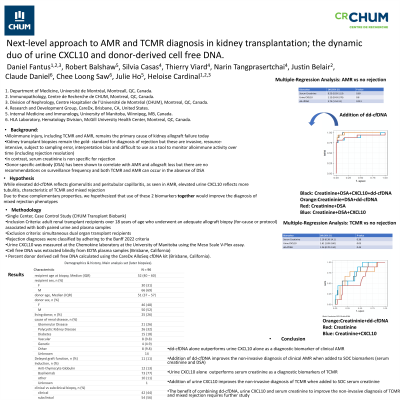Back

(P218) Next-level approach to AMR and TCMR diagnosis in kidney transplantation; the dynamic duo of urine CXCL10 and donor-derived cell free DNA.
Location: Platinum Ballroom

Poster Presenter(s)
Aim: Although an allograft biopsy is required to diagnose rejection, this procedure is invasive and difficult to use as a tool to monitor alloimmune activity. While there is evidence that donor derived cell free DNA (dd-cfDNA) performs well as a biomarker of clinical antibody-mediated rejection (AMR), its ability to identify T cell mediated rejection (TCMR) remains unclear. In contrast, urine chemokines are well-characterised biomarkers of tubulitis. Due to these complementary properties, we hypothesized that use of these 2 biomarkers together would improve the diagnosis of rejection phenotypes marked predominantly by tubulitis.
Method: A retrospective study was conducted whereby 126 kidney transplant biopsies, with paired plasma and urine samples, were selected from the CHUM transplant biobank. Banff 2019 criteria were followed to generate the following diagnostic categories: 20 cases of AMR (including suspicious AMR where 2 of 3 diagnostic criteria were met), 10 cases of low grade TCMR (Banff 1A or 1B), 7 cases of high grade TCMR (Banff 2B or greater) and 43 cases with normal histology (i,t,v,g and ptc =0). Urine CXCL10 was measured at the University of Manitoba using the Meso Scale V-Plex assay. Cell free DNA was extracted from EDTA plasma samples and percent donor derived cell free DNA calculated using the CareDx AlloSeq cfDNA kit. Cut-offs of 0.5% dd-cfDNA and 13 pg/ml urine CXCL10 were selected for each assay, respectively.
Results: The AUC for AMR (including suspicious AMR vs normal) was 0.952 (0.893-1000) using dd-cfDNA alone. In contrast, the AUC for urine CXCL10 for AMR was 0.595 (0.469-0.722) and increased to 0.969 (0.923-1.000) when combined with dd-cfDNA (p=1.71X10-8). When examining high grade TCMR, AUC for dd-cfDNA was 0.762 (0.562-0.963). In contrast, AUC for urine CXCL10 was 0.681 (0.474-0.888) and increased to 0.792 (0.585-1.000) when dd-cfDNA was added (p=0.16). For low grade TCMR, AUC was 0.577 (0.442-0.711) for dd-cfDNA. AUC for urine CXCL10 was 0.595 (0.424-0.767) and increased to 0.652 (0.473-0.832) (p=0.32) when combined with dd-cfDNA.
Conclusion: Urine CXCL10 is a weaker diagnostic biomarker of AMR compared to dd-cfDNA. In contrast, when evaluating TCMR, there was no clear advantage of one biomarker over the other, though their combination may improve diagnosis. These findings require external validation and prospective studies.
Method: A retrospective study was conducted whereby 126 kidney transplant biopsies, with paired plasma and urine samples, were selected from the CHUM transplant biobank. Banff 2019 criteria were followed to generate the following diagnostic categories: 20 cases of AMR (including suspicious AMR where 2 of 3 diagnostic criteria were met), 10 cases of low grade TCMR (Banff 1A or 1B), 7 cases of high grade TCMR (Banff 2B or greater) and 43 cases with normal histology (i,t,v,g and ptc =0). Urine CXCL10 was measured at the University of Manitoba using the Meso Scale V-Plex assay. Cell free DNA was extracted from EDTA plasma samples and percent donor derived cell free DNA calculated using the CareDx AlloSeq cfDNA kit. Cut-offs of 0.5% dd-cfDNA and 13 pg/ml urine CXCL10 were selected for each assay, respectively.
Results: The AUC for AMR (including suspicious AMR vs normal) was 0.952 (0.893-1000) using dd-cfDNA alone. In contrast, the AUC for urine CXCL10 for AMR was 0.595 (0.469-0.722) and increased to 0.969 (0.923-1.000) when combined with dd-cfDNA (p=1.71X10-8). When examining high grade TCMR, AUC for dd-cfDNA was 0.762 (0.562-0.963). In contrast, AUC for urine CXCL10 was 0.681 (0.474-0.888) and increased to 0.792 (0.585-1.000) when dd-cfDNA was added (p=0.16). For low grade TCMR, AUC was 0.577 (0.442-0.711) for dd-cfDNA. AUC for urine CXCL10 was 0.595 (0.424-0.767) and increased to 0.652 (0.473-0.832) (p=0.32) when combined with dd-cfDNA.
Conclusion: Urine CXCL10 is a weaker diagnostic biomarker of AMR compared to dd-cfDNA. In contrast, when evaluating TCMR, there was no clear advantage of one biomarker over the other, though their combination may improve diagnosis. These findings require external validation and prospective studies.

